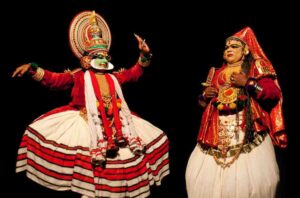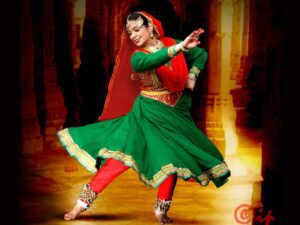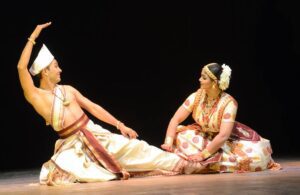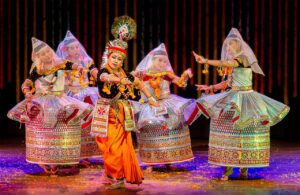Indian classical dance
In Indian art and culture Indian classical dance is a dynamic art form that combines intricate rhythms, spirituality, and storytelling. It has its roots in India’s cultural legacy.
Every dance form, including Kathak, Odissi, Kuchipudi, Manipuri, Mohiniyattam, and Kathakali, has its own unique expressions, costumes, and movements. Dancers’ express emotions and stories through rhythmic footwork, facial expressions (abhinaya), and hand gestures (mudras), which are frequently drawn from religious texts and mythology.
These dances create a captivating fusion of visual and aural art that has been passed down through the generations. They are distinguished by their exact technique, intricate costumes, and strong connection to music.
Kathakali Indian classical dance In Indian art and culture
In the temples of Kerala, under the patronage of feudal lords, two forms of dance-drama, Ramanatam and Krishnatam, were developed, in which the story of Ramayana and Mahabharata was told, these folk drama traditions became the source of the emergence of Kathakali Indian classical dance,
the name is derived from Katha meaning story and Kali means drama. Koodiyattam (Sanskrit theatrical tradition) as well as other ancient martial arts exhibitions.

It is a wonderful combination of music, dance and drama. With the dissolution of the feudal system, Kathakali as a form of art began to emerge. It was revived in 1930 by the famous Malayalam poet V. N. Menon under the supervision of Mukunda Raja. Some of the characteristics of Kathakali Indian classical dance are written below:
Kathakali is usually performed by male troupes:
Kathakali is performed with the least use of support in the presentation. Head caps are used with superimposed make-up of faces for different letters. Different colors have their own significance:
Green indicates nobility, gods and virtue red spots next to the nose indicate majestic pride
Black is used to indicate versatility and vision. Yellow is for saints and women. A face painted entirely red indicates evil. White beard indicates beings with higher consciousness and divinity. It involves both dance and drama and the two are so combined that they cannot be clearly distinguished. Most of the Kathakali singing is a grand simulation of the eternal struggle between good and evil.
Its theme is stories narrated in epics and puranas. It is also called Purva ballads. The language used for Kathakali songs is a mixture of Manipravalam, i.e., Malayalam and culture. Music is important to convey the whole play correctly to the audience.
Various musical compositions are used while performing the play for depth. Gestures are the precious ornament of the whole dance-drama. Kathakali is written in the representation of rasa through the eyes and eye through which the story is communicated. The nine important facial expressions called Narvas are taught to express different emotions.
Extensive gestures are also used in the hand. Performing this dance form requires rigorous training. Kathakali is performed in an open theatre or temple complex covered with thick mats with lush green trees of Kerala providing a backdrop. Brass lamps are used for illumination. The arrival of dawn with the continuous sound of drums, holes and mandalas and the beginning and ending for the Kathakali rendition signifies the Kathakali element
Famous exponents: Guru Kunju Kurup, Gopinath, Kotakkal Sivaraman Rita Ganguly.
Mohiniyattam Indian classical dance In Indian art and culture
Mohiniyattam Indian classical dance or Mohini means beauty feminine and Attam means dance.The Indian classical dance is originally a dancer-solo, developed further by Vadivelu in the 19th century. It gained importance under the rulers of Travancore in the state of Kerala. Swathi Thirunal’s patronage is noteworthy. Having become obsolete, the famous Malayalam poet V.N. reviewed it with mana Kalyani Amma.

Following is some of the features of Mohiniyattam Indian classical dance:
Mohiniyattam Indian classical dance combines the enthusiasm of Kathakali with the elegance and softness of Bharatanatyam. There is no beating of feet, the footsteps are gentle.
Mohiniyattam Indian classical dance narrates the story of the feminine dance of Vishnu. Like other classical dances, it has its own Narita and dance aspects. Lasya aspect (beauty, elegance) dominates the singing of Mohiniyattam Indian classical dance. This dance is mainly performed by dancers.
Dance is accompanied by music and songs due to white and white being the main color and golden vine color designs, the costumes have special importance in Mohiniyattam. There is no sophisticated makeup.
Leather bands or bells (Pungaru) are worn by the dancers on her ankles. The air element is expressed through the performance of Mohiniyattam. Athavakulal is a collection of 40 basic dance movements Musical instruments used are Jhani Veena Dhol Flute etc. Famous exponents Sunanda Nair, Kalamandalam, Maduri, amma, jayaperdas etc.
Odyssey Indian classical dance In Indian art and culture
The caves of Udayagiri Khandagiri provide some early examples for Odissi Indian classical dance. This dance form is derived from the Ondhara dance mentioned in the Natay Shastra. This is mainly decided by the Maharishi and was patronized by the Jain king Khara vela.
Young boys were recruited to continue the art form, they were equipped as women, they came to be known as Gotipua, another form of this art was the practice or performance of Nartala to continue the art form that continued in the royal courts. Odissi gained international acclaim through the efforts of Charles Fabry and Indrani Rahman in the mid-twentieth century.

Some of the features of Odissi are as follows
: In expressing emotions, it is similar to Bharatanatyam in the use of mudras and rations. Tribhangamudra means three-folded form of the body. Odisha Indian classical dance is in continuous form.
Chowk asana with outstretched hands with it denotes male element. During the dance, the lower part of the body remains largely sat and the dhad moves with the rhythm. During the continuous part, the gestures of the hand play an important role in the communication of expressions. Odisha is unique in its representation of sustained Lalita sensuality and beauty. Pallavi which included facial expressions and song pattern. Tharijjham in which pure dance is honored before the finale.
In Indian art and culture There are two types of concluding or lasting. Trikhand Mujra is another mode of finale in which the performers take permission from the deities to exit the stage, Hindustani classical music accompaniments Odissi Indian classical dance and Manjira, Adole, Sitar, flute etc. Anandpur Lai Taal depicting liberation from salvation.
In this continuum, the songs of Geet Govinda written by Jayadev are used with the compositions of some local poets, super skirt configuration by dance, silver ornaments, tall necklace etc. are worn. Famous supporter Guru Pankaj Charan Das Guru Kelucharan Mohapatra Sonal Man Singh.
Manipuri Indian classical dance
Manipuri Indian classical dance form finds its mythological origin in the divine routine of Shiva and Parvati with local Gandharva in the valleys of Manipur This Indian classical dance gained prominence with the advent of Vaishnavism in the 15th century Krishnan became the central theme of this Indian classical dance.
In modern times, in the 18th century, King Bhag Chander of Manipur attempted to revive Rita in Manipur, Rabindranath Tagore brought this dance form back into vogue when he popularized it in Santiniketan.
Some of the characteristics of Manipuri Indian classical dance are as follows
Manipuri Indian classical dance is unique because of its emphasis on Bhagti’s sexuality. The face is covered with a thin veil and facial expression is of little importance. Hand gestures and gentle movement of the feet are important.
This Indian classical dance involves both Tandav and Lasya, but the emphasis is on the corpse. Women wear long skirts Meditation is mainly focused on slow and elegant full movement of the hand and knee position Nose closure pose in which the body is connected through workers in the shape of eight is important pose in Manipur dance forms.
Ras Leela Radhakrishnan’s love story Manipur dance is a recurring theme of singing. Dhol is a complex element of pung singing, flutes, khartal, dol etc. accompaniment with music in which compositions of Jayadeva and Chandidas are widely used. Thang, Ta and San kirtan are also influenced by Manipura Nirantara. Famous supporters, Birju Maharaj, Lakshu Maharaj, Sitara Devi, Damayanti Joshi etc.
Kathak Indian classical dance
Kathak Indian classical dance is a traditional dance form of Uttar Pradesh, derived from the Ras Leela of Brij Bhumi, which derives its name from Katika who used to render poems taken from the epic with gestures and music. During the Mughal era, this form of dance was also presented in an aphrodisiac style.
Some of the characteristics of kathak Indian classical dance are as follows
An important feature of Kathak is the growth of different gharanas as it is based on the Hindustani music genre. Lucknow It reached its zenith during the reign of Nawab Wajid Ali Shah It emphasizes a lot of expression and fine.
Started by Jaipur this gharana emphasizes on flow speed and long level pattern. Raigad is it developed under the patronage of Raja Chakradhar Singh. This Aghaat is unique due to its emphasis on complete music. Banaras It is developed under the patronage of Janaki Prasad. It uses more floor and lays special emphasis on symmetry. Kathak Indian classical dance is characterized by the use of complex steps and chakras. Kathak presentation has the following components: Anandya promotional presentation through which the dancer enters the stage.

Thaat, which has light but varied movements, small fragments of the break and piece, is the highlight of the jugalbandi Kathak performance, in which there is a competitive play between the tabla player and the dancer. The tarana is similar to the thilan, which consists of pure lementary operations before termination.
Satriya Indian classical dance
Satria Indian classical dance in its modern form was popularized by the Vaishnav saint Sankaradevi in the 15th century. This art derives its name from the Vaishnava monasteries known as a “satra”.
where it was mainly practiced. Awesome. It has been mentioned in the ancient text “Natay shastra” of sage Bahat Muni. It is inspired by the bhakti movement. Some of the future of Satriya Indian classical dance include this Indian classical dance form is a mixture of various dance forms prevalent in assam, ojpali and devadasi.

Conclusion
In summary, Indian classical dance combines complex choreography with profound spiritual expression to embody a rich cultural legacy. From Bharatanatyam to Kathak, all of the classical forms share a common emphasis on storytelling, rhythm, and emotion, but they also carry unique regional influences.
In Indian art and culture The dancers tell ancient myths and stories with precise hand gestures, facial expressions, and precise movements known as mudras. They are dressed in traditional clothing. The essence of tradition has been preserved by these art forms, which have developed to resonate with modern audiences while also preserving India’s cultural narratives. A timeless celebration of India’s artistic and spiritual heritage is Indian classical dance.

